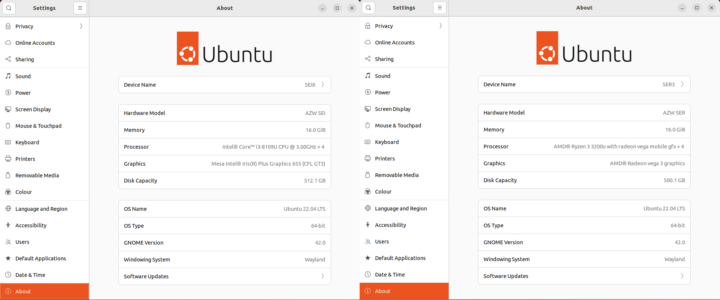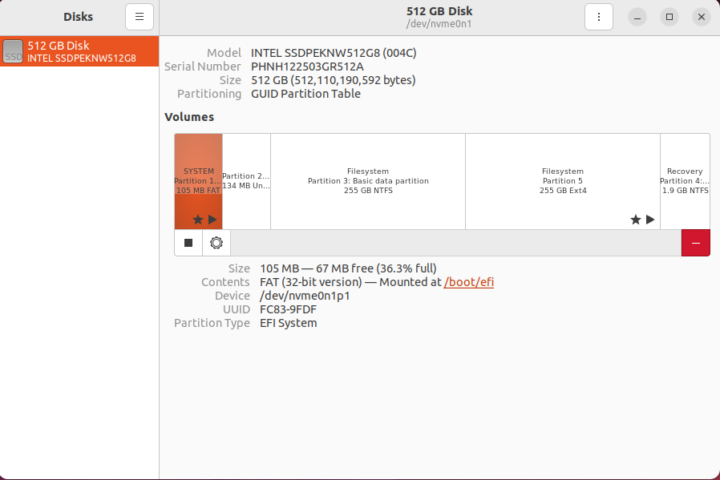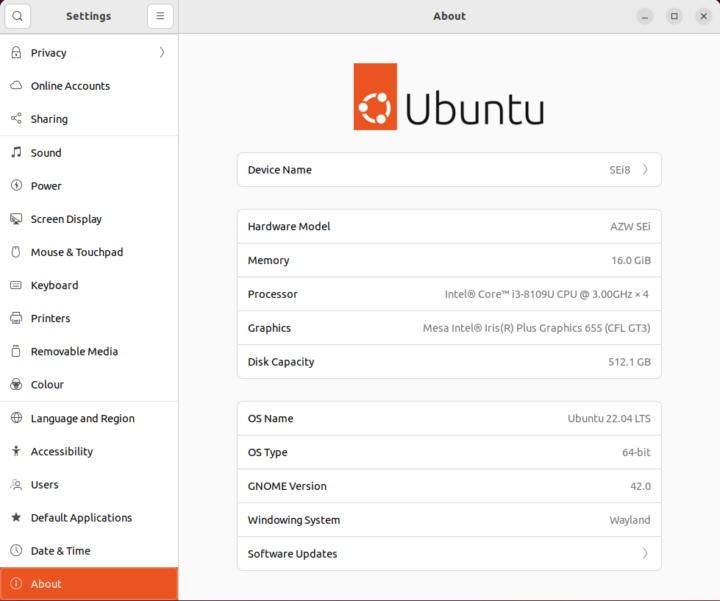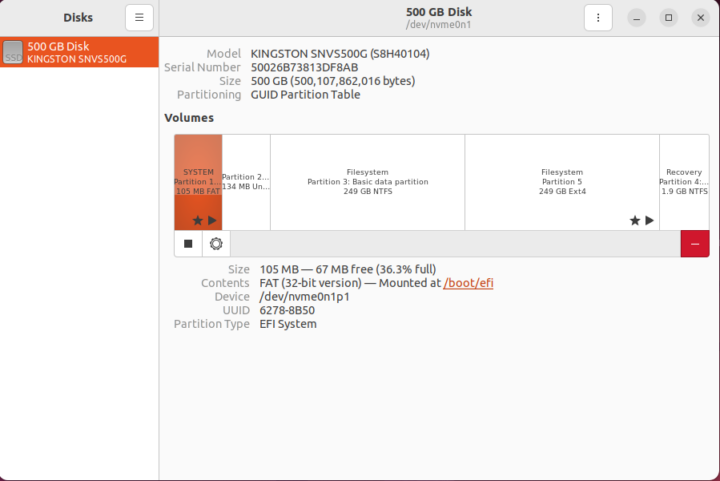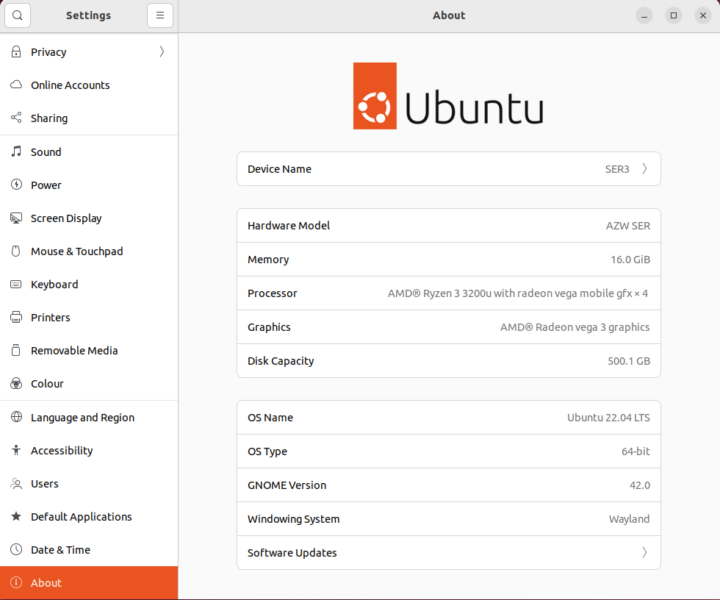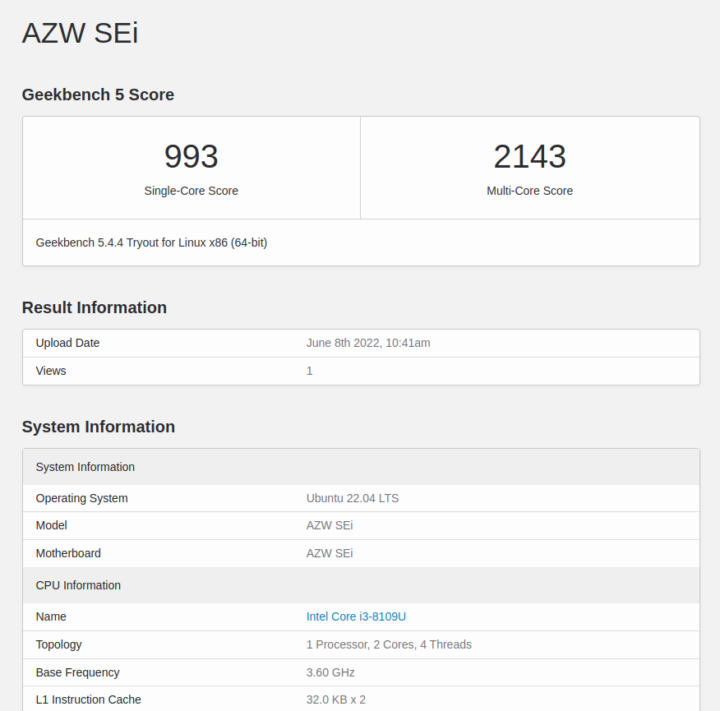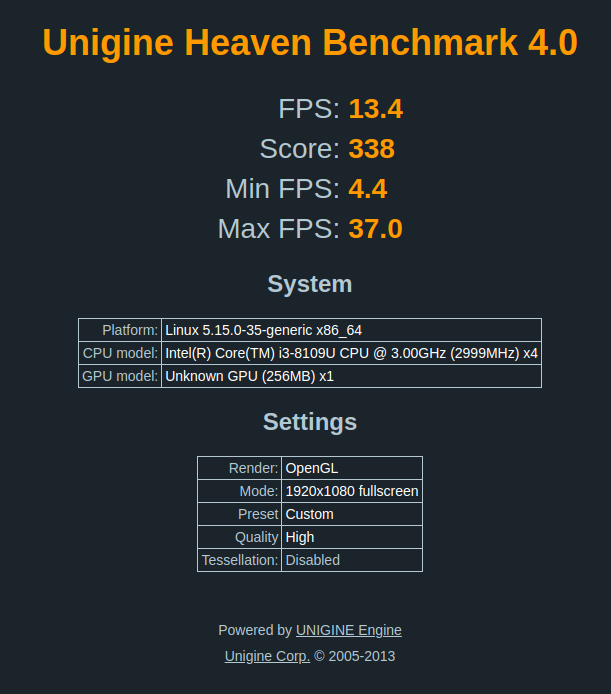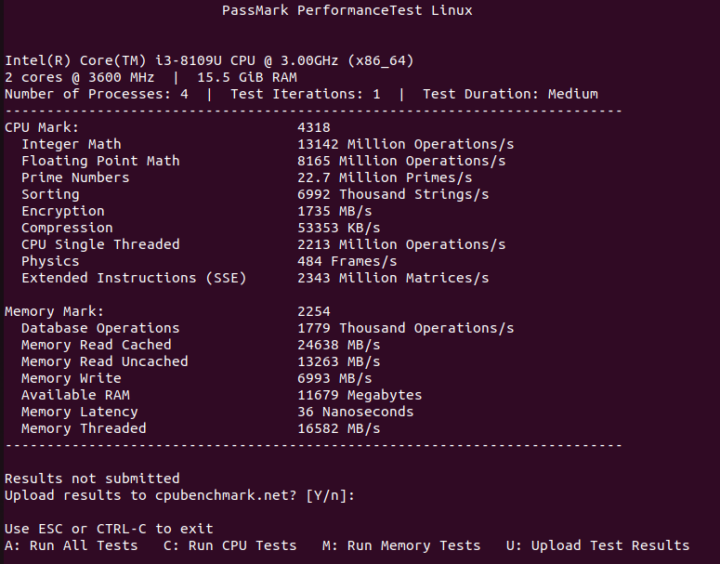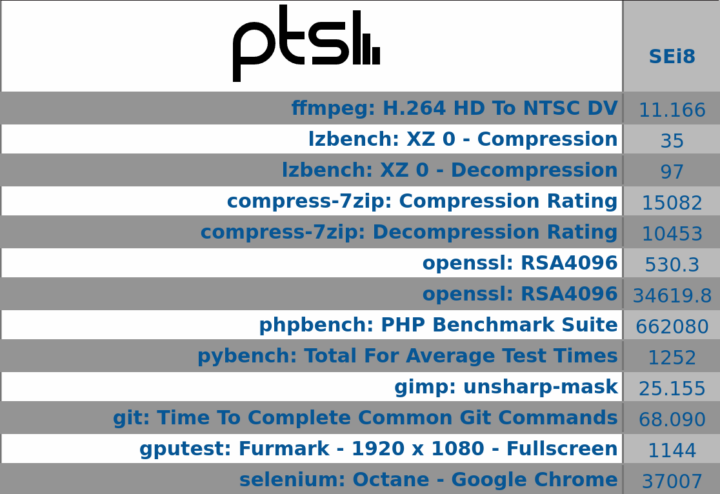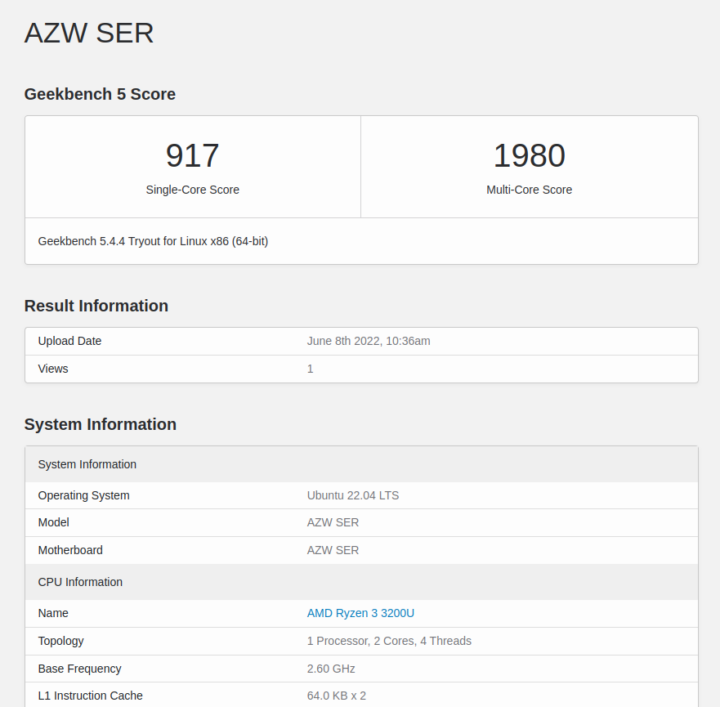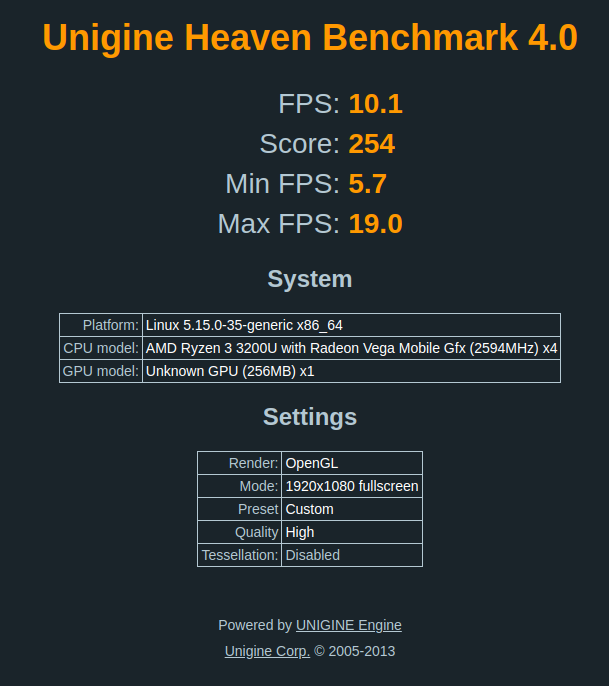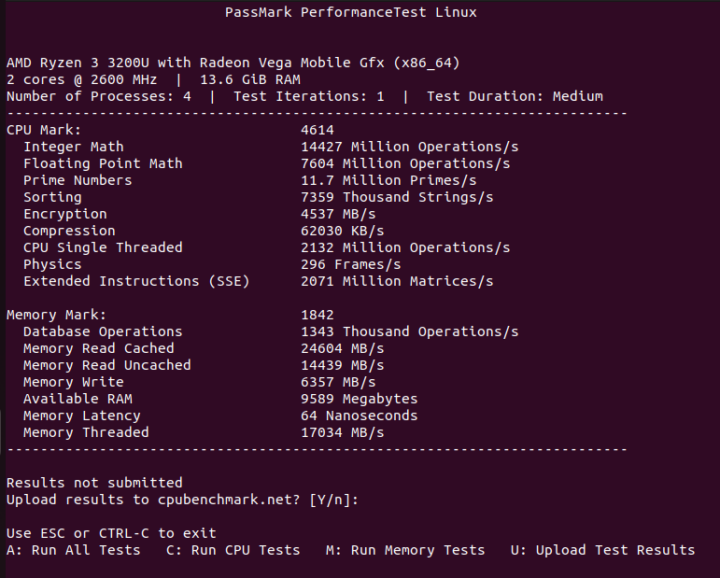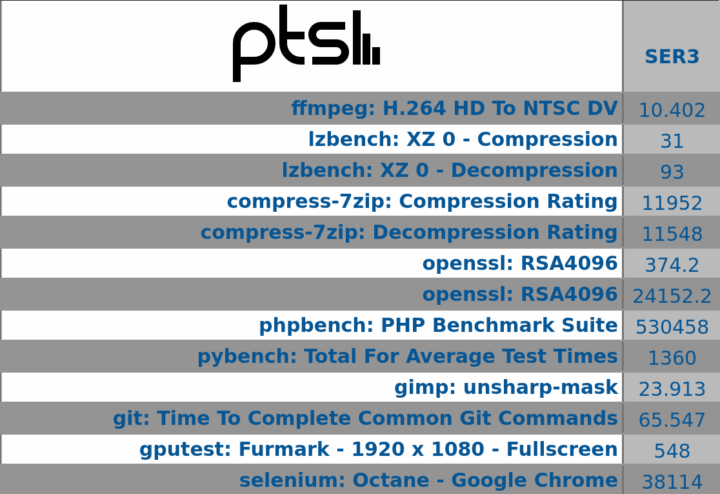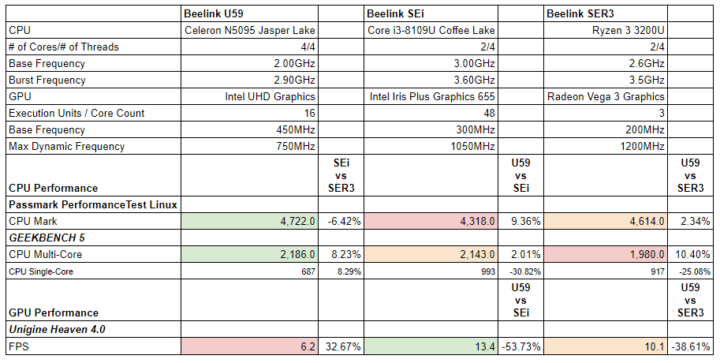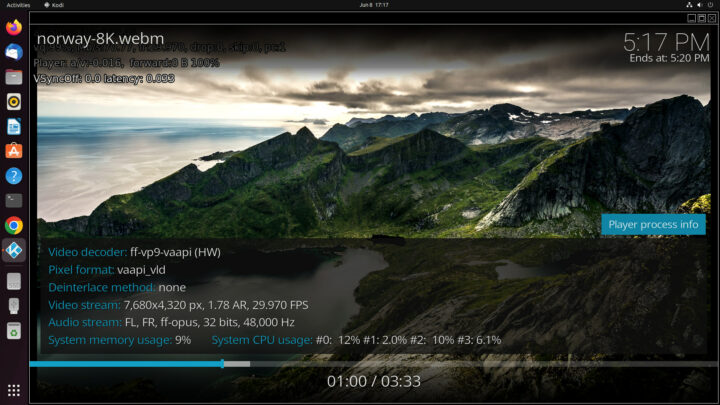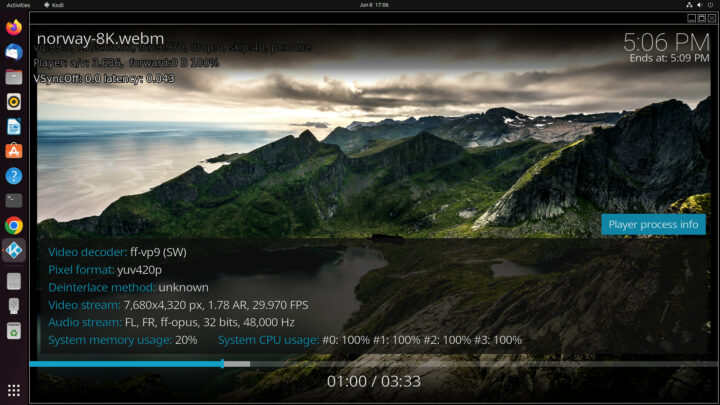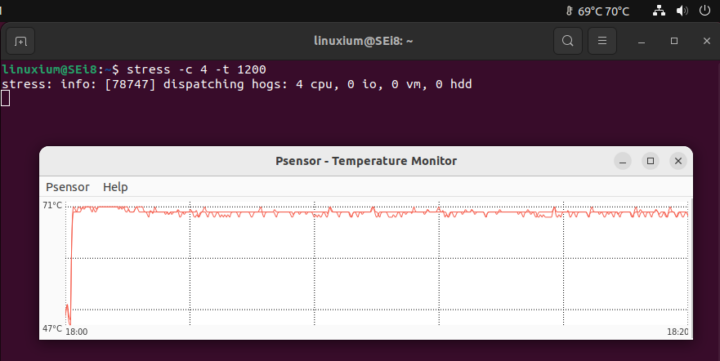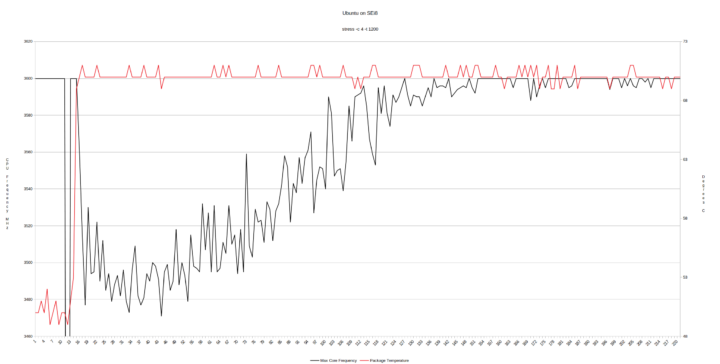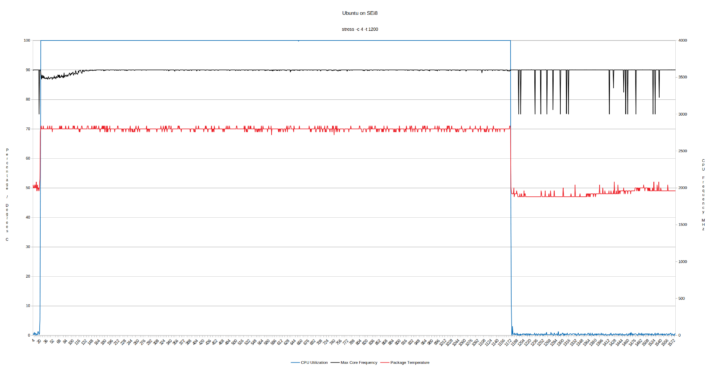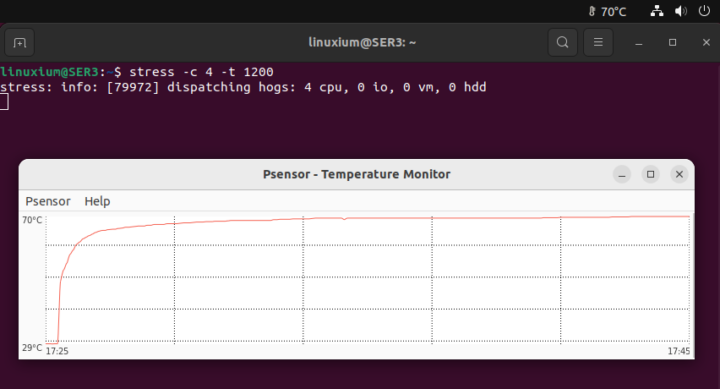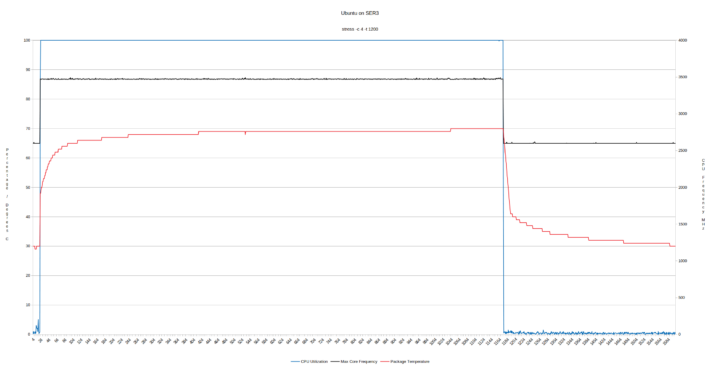Previously, I reviewed Beelink’s new SEi8 and SER3 mini PCs running Windows 11, so in this part, I will cover Ubuntu 22.04.
Hardware Recap
The SEi8 is an actively cooled Intel mini PC that physically consists of a 124 x 113 x 41 (4.88 x 4.45 x 1.61 inches) square metal case with a plastic top and uses Intel’s 14++ nm Coffee Lake Refresh Core i3-8109U processor from 2018 which is a dual-core 4-thread 3.00 GHz mobile processor boosting to 3.60 GHz with Intel’s Iris Plus Graphics 655.
In comparison, the SER3 is an AMD mini PC and is physically very similar, consisting of a 126 x 113 x 40mm (4.96 x 4.45 x 1.57 inches) square metal case. It is also actively cooled and uses AMD’s 14 nm Zen Ryzen 3 3200U Picasso processor from 2019 which is a dual-core 4-thread 2.6 GHz mobile processor boosting to 3.5 GHz with Radeon Vega 3 Graphics.
Internally each has a replaceable M.2 2230 Wi-Fi 5 (or 802.11ac) Intel Wireless-AC 3165 card and an M.2 2280 NVMe PCIe Gen 3.0 SSD drive with the SEi8 review model including a 512 GB Intel 660p drive and the SER3 review model including a 500 GB Kingston drive.
Each review model only had one of the two SODIMM memory slots populated with a single stick of Crucial 16 GB DDR4 3200 MHz single-rank memory configured to run at 2400 MHz on both mini PCs.
Review Methodology
When reviewing mini PCs, I typically compare their performance against some of the more recently released mini PCs. I now review using Ubuntu 22.04 LTS and test with a selection of commonly used Linux benchmarks together with Thomas Kaiser’s ‘sbc-bench’ which is a small set of different CPU performance tests focusing on server performance when run on Ubuntu. I also compile the v5.15 Linux kernel using the default config as a test of performance using a real-world scenario. Finally, I use ‘Phoronix Test Suite’ so that I can benchmark with the same set of tests on Windows for comparison purposes.
Prior to benchmarking, I perform all necessary installations and updates to run the latest version of the OS. I also capture some basic details of the device for the OS.
Installation Issues
After shrinking the Windows partition in half and creating a new partition, I installed Ubuntu using an Ubuntu 22.04 ISO as dual boot on each mini PC.
With both devices, there are various BIOS errors being reported in the ‘dmesg’ although the significance of which has not been determined.
On the SEi8 these are as follows:

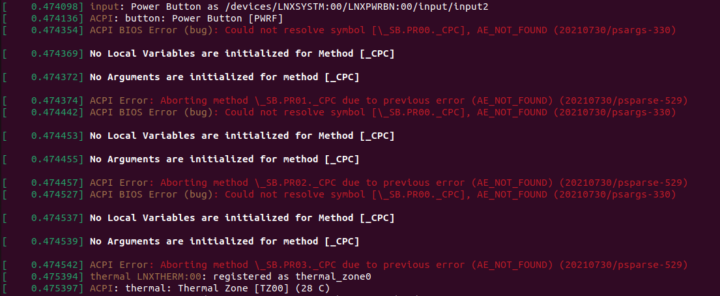
Beelink SEi8 & SER3 Ubuntu 22.04 Performance
After installation and updates, a brief check showed working Wi-Fi, Bluetooth, and Ethernet.
The key hardware information under Ubuntu 22.04 for the SEi8 is as follows:
|
1 2 3 4 5 6 7 8 9 10 11 12 13 14 15 16 17 18 19 20 21 22 23 24 25 26 27 28 29 30 31 32 33 34 35 36 37 38 39 40 41 42 43 44 45 46 47 48 49 50 51 52 53 54 55 56 57 58 59 60 61 62 63 64 65 66 67 68 69 70 71 72 73 74 75 76 77 78 79 80 81 82 83 84 85 86 87 88 89 90 91 92 93 94 95 96 97 98 99 100 101 102 103 104 105 106 107 108 109 110 111 112 113 114 115 116 117 118 119 120 121 122 123 124 125 126 127 128 129 130 131 132 133 134 135 136 137 138 139 140 141 142 143 144 145 146 147 148 149 150 151 152 153 154 155 156 157 158 159 160 161 162 163 164 165 166 167 168 169 170 171 172 173 174 175 176 177 178 179 180 181 182 183 184 185 186 187 188 189 190 191 192 193 194 195 196 197 198 199 200 201 202 203 204 205 206 207 208 209 210 211 212 213 214 215 216 217 218 219 220 221 222 223 224 225 226 227 228 229 230 231 232 233 234 235 236 237 238 239 240 241 242 243 244 245 246 247 248 |
linuxium@SEi8:~$ lsb_release -a Distributor ID: Ubuntu Description: Ubuntu 22.04 LTS Release: 22.04 Codename: jammy linuxium@SEi8:~$ linuxium@SEi8:~$ uname -a Linux SEi8 5.15.0-35-generic #36-Ubuntu SMP Sat May 21 02:24:07 UTC 2022 x86_64 x86_64 x86_64 GNU/Linux linuxium@SEi8:~$ linuxium@SEi8:~$ inxi -Fzc0y-1 System: Kernel: 5.15.0-35-generic x86_64 bits: 64 Console: pty pts/1 Distro: Ubuntu 22.04 LTS (Jammy Jellyfish) Machine: Type: Desktop Mobo: AZW model: SEi serial: <filter> UEFI: American Megatrends v: 5.13 date: 03/01/2022 CPU: Info: dual core model: Intel Core i3-8109U bits: 64 type: MT MCP cache: L2: 512 KiB Speed (MHz): avg: 3600 min/max: 400/3600 cores: 1: 3600 2: 3601 3: 3601 4: 3601 Graphics: Device-1: Intel CoffeeLake-U GT3e [Iris Plus Graphics 655] driver: i915 v: kernel Display: server: X.Org v: 1.22.1.1 driver: gpu: i915 note: X driver n/a resolution: 1920x1080~60Hz OpenGL: renderer: Mesa Intel Iris Plus Graphics 655 (CFL GT3) v: 4.6 Mesa 22.0.1 Audio: Device-1: Intel Cannon Point-LP High Definition Audio driver: snd_hda_intel Device-2: KTMicro KT USB Audio type: USB driver: hid-generic,snd-usb-audio,usbhid Sound Server-1: ALSA v: k5.15.0-35-generic running: yes Sound Server-2: PulseAudio v: 15.99.1 running: yes Sound Server-3: PipeWire v: 0.3.48 running: yes Network: Device-1: Realtek RTL8111/8168/8411 PCI Express Gigabit Ethernet driver: r8169 IF: enp1s0 state: up speed: 1000 Mbps duplex: full mac: <filter> Device-2: Intel Wireless 3165 driver: iwlwifi IF: wlp2s0 state: down mac: <filter> Bluetooth: Device-1: Intel Bluetooth wireless interface type: USB driver: btusb Report: hciconfig ID: hci0 state: up address: <filter> bt-v: 2.1 Drives: Local Storage: total: 476.94 GiB used: 17.29 GiB (3.6%) ID-1: /dev/nvme0n1 vendor: Intel model: SSDPEKNW512G8 size: 476.94 GiB Partition: ID-1: / size: 232.71 GiB used: 17.26 GiB (7.4%) fs: ext4 dev: /dev/nvme0n1p5 ID-2: /boot/efi size: 96 MiB used: 32.3 MiB (33.6%) fs: vfat dev: /dev/nvme0n1p1 Swap: ID-1: swap-1 type: file size: 2 GiB used: 0 KiB (0.0%) file: /swapfile Sensors: System Temperatures: cpu: 27.8 C pch: 31.0 C mobo: N/A Fan Speeds (RPM): N/A Info: Processes: 235 Uptime: 3m Memory: 15.53 GiB used: 1.21 GiB (7.8%) Shell: new-review-test inxi: 3.3.13 linuxium@SEi8:~$ linuxium@SEi8:~$ df -h Filesystem Size Used Avail Use% Mounted on tmpfs 1.6G 2.0M 1.6G 1% /run /dev/nvme0n1p5 233G 18G 204G 8% / tmpfs 7.8G 0 7.8G 0% /dev/shm tmpfs 5.0M 4.0K 5.0M 1% /run/lock /dev/nvme0n1p1 96M 33M 64M 34% /boot/efi tmpfs 1.6G 2.4M 1.6G 1% /run/user/1000 linuxium@SEi8:~$ linuxium@SEi8:~$ lsblk -a NAME MAJ:MIN RM SIZE RO TYPE MOUNTPOINTS loop0 7:0 0 61.9M 1 loop /snap/core20/1405 loop1 7:1 0 4K 1 loop /snap/bare/5 loop2 7:2 0 61.9M 1 loop /snap/core20/1494 loop3 7:3 0 162.2M 1 loop /snap/firefox/1406 loop4 7:4 0 248.8M 1 loop /snap/gnome-3-38-2004/99 loop5 7:5 0 155.6M 1 loop /snap/firefox/1232 loop6 7:6 0 81.3M 1 loop /snap/gtk-common-themes/1534 loop7 7:7 0 45.9M 1 loop /snap/snap-store/582 loop8 7:8 0 43.6M 1 loop /snap/snapd/15177 loop9 7:9 0 45.9M 1 loop /snap/snap-store/575 loop10 7:10 0 44.7M 1 loop /snap/snapd/15904 loop11 7:11 0 284K 1 loop /snap/snapd-desktop-integration/10 loop12 7:12 0 284K 1 loop /snap/snapd-desktop-integration/14 loop13 7:13 0 0B 0 loop nvme0n1 259:0 0 476.9G 0 disk ├─nvme0n1p1 259:1 0 100M 0 part /boot/efi ├─nvme0n1p2 259:2 0 128M 0 part ├─nvme0n1p3 259:3 0 237.5G 0 part ├─nvme0n1p4 259:4 0 1.7G 0 part └─nvme0n1p5 259:5 0 237.5G 0 part / linuxium@SEi8:~$ linuxium@SEi8:~$ sudo lshw -C cpu *-cpu description: CPU product: Intel(R) Core(TM) i3-8109U CPU @ 3.00GHz vendor: Intel Corp. physical id: 47 bus info: cpu@0 version: 6.142.10 serial: <filter> slot: U3E1 size: 3597MHz capacity: 4005MHz width: 64 bits clock: 100MHz capabilities: lm fpu fpu_exception wp vme de pse tsc msr pae mce cx8 apic sep mtrr pge mca cmov pat pse36 clflush dts acpi mmx fxsr sse sse2 ss ht tm pbe syscall nx pdpe1gb rdtscp x86-64 constant_tsc art arch_perfmon pebs bts rep_good nopl xtopology nonstop_tsc cpuid aperfmperf pni pclmulqdq dtes64 monitor ds_cpl vmx est tm2 ssse3 sdbg fma cx16 xtpr pdcm pcid sse4_1 sse4_2 x2apic movbe popcnt tsc_deadline_timer aes xsave avx f16c rdrand lahf_lm abm 3dnowprefetch cpuid_fault epb invpcid_single pti ssbd ibrs ibpb stibp tpr_shadow vnmi flexpriority ept vpid ept_ad fsgsbase tsc_adjust bmi1 avx2 smep bmi2 erms invpcid mpx rdseed adx smap clflushopt intel_pt xsaveopt xsavec xgetbv1 xsaves dtherm ida arat pln pts hwp hwp_notify hwp_act_window hwp_epp md_clear flush_l1d cpufreq configuration: cores=2 enabledcores=2 microcode=234 threads=4 linuxium@SEi8:~$ linuxium@SEi8:~$ sudo lshw -C memory *-firmware description: BIOS vendor: American Megatrends Inc. physical id: 0 version: 5.13 date: 03/01/2022 size: 64KiB capacity: 16MiB capabilities: pci upgrade shadowing cdboot bootselect socketedrom edd int13floppy1200 int13floppy720 int13floppy2880 int5printscreen int9keyboard int14serial int17printer acpi usb biosbootspecification uefi *-memory description: System Memory physical id: 3a slot: System board or motherboard size: 16GiB *-bank:0 description: Project-Id-Version: lshwReport-Msgid-Bugs-To: FULL NAME <EMAIL@ADDRESS>PO-Revision-Date: 2012-02-02 13:04+0000Last-Translator: Joel Addison <jaddi27@gmail.com>Language-Team: English (Australia) <en_AU@li.org>MIME-Version: 1.0Content-Type: text/plain; charset=UTF-8Content-Transfer-Encoding: 8bitX-Launchpad-Export-Date: 2022-04-15 01:03+0000X-Generator: Launchpad (build 5cc3bd61c85a328825183f316ddd801c0f7d7ef2)Project-Id-Version: lshwReport-Msgid-Bugs-To: FULL NAME <EMAIL@ADDRESS>PO-Revision-Date: 2012-02-02 13:04+0000Last-Translator: Joel Addison <jaddi27@gmail.com>Language-Team: English (Australia) <en_AU@li.org>MIME-Version: 1.0Content-Type: text/plain; charset=UTF-8Content-Transfer-Encoding: 8bitX-Launchpad-Export-Date: 2022-04-15 01:03+0000X-Generator: Launchpad (build 5cc3bd61c85a328825183f316ddd801c0f7d7ef2) [empty] physical id: 0 slot: ChannelA-DIMM0 *-bank:1 description: SODIMM DDR4 Synchronous 3200 MHz (0.3 ns) product: CT16G4SFS832A.C8FE vendor: 859B physical id: 1 serial: <filter> slot: ChannelB-DIMM0 size: 16GiB width: 64 bits clock: 3200MHz (0.3ns) *-cache:0 description: L1 cache physical id: 44 slot: L1 Cache size: 128KiB capacity: 128KiB capabilities: synchronous internal write-back unified configuration: level=1 *-cache:1 description: L2 cache physical id: 45 slot: L2 Cache size: 512KiB capacity: 512KiB capabilities: synchronous internal write-back unified configuration: level=2 *-cache:2 description: L3 cache physical id: 46 slot: L3 Cache size: 4MiB capacity: 4MiB capabilities: synchronous internal write-back unified configuration: level=3 *-memory UNCLAIMED description: RAM memory product: Cannon Point-LP Shared SRAM vendor: Intel Corporation physical id: 14.2 bus info: pci@0000:00:14.2 version: 30 width: 64 bits clock: 33MHz (30.3ns) capabilities: pm cap_list configuration: latency=0 resources: memory:a141e000-a141ffff memory:a1428000-a1428fff linuxium@SEi8:~$ linuxium@SEi8:~$ free -mh total used free shared buff/cache available Mem: 15Gi 730Mi 13Gi 209Mi 1.1Gi 14Gi Swap: 2.0Gi 0B 2.0Gi linuxium@SEi8:~$ linuxium@SEi8:~$ sudo lshw -C network *-network description: Ethernet interface product: RTL8111/8168/8411 PCI Express Gigabit Ethernet Controller vendor: Realtek Semiconductor Co., Ltd. physical id: 0 bus info: pci@0000:01:00.0 logical name: enp1s0 version: 15 serial: <filter> size: 1Gbit/s capacity: 1Gbit/s width: 64 bits clock: 33MHz capabilities: pm msi pciexpress msix bus_master cap_list ethernet physical tp mii 10bt 10bt-fd 100bt 100bt-fd 1000bt-fd autonegotiation configuration: autonegotiation=on broadcast=yes driver=r8169 driverversion=5.15.0-35-generic duplex=full firmware=rtl8168h-2_0.0.2 02/26/15 ip=<filter> latency=0 link=yes multicast=yes port=twisted pair speed=1Gbit/s resources: irq:18 ioport:3000(size=256) memory:a1304000-a1304fff memory:a1300000-a1303fff *-network description: Wireless interface product: Wireless 3165 vendor: Intel Corporation physical id: 0 bus info: pci@0000:02:00.0 logical name: wlp2s0 version: 81 serial: <filter> width: 64 bits clock: 33MHz capabilities: pm msi pciexpress bus_master cap_list ethernet physical wireless configuration: broadcast=yes driver=iwlwifi driverversion=5.15.0-35-generic firmware=29.4063824552.0 7265D-29.ucode latency=0 link=no multicast=yes wireless=IEEE 802.11 resources: irq:134 memory:a1200000-a1201fff linuxium@SEi8:~$ linuxium@SEi8:~$ sudo lshw -C display *-display description: VGA compatible controller product: CoffeeLake-U GT3e [Iris Plus Graphics 655] vendor: Intel Corporation physical id: 2 bus info: pci@0000:00:02.0 logical name: /dev/fb0 version: 01 width: 64 bits clock: 33MHz capabilities: pciexpress msi pm vga_controller bus_master cap_list rom fb configuration: depth=32 driver=i915 latency=0 resolution=2560,1080 resources: irq:135 memory:a0000000-a0ffffff memory:90000000-9fffffff ioport:4000(size=64) memory:c0000-dffff linuxium@SEi8:~$ linuxium@SEi8:~$ dmesg | grep "MMC card" linuxium@SEi8:~$ linuxium@SEi8:~$ dmesg | egrep -i sdhci\|mmc [ 0.239128] PCI: MMCONFIG for domain 0000 [bus 00-ff] at [mem 0xe0000000-0xefffffff] (base 0xe0000000) [ 0.239128] PCI: MMCONFIG at [mem 0xe0000000-0xefffffff] reserved in E820 [ 1.125117] sdhci: Secure Digital Host Controller Interface driver [ 1.125119] sdhci: Copyright(c) Pierre Ossman [ 1.155787] sdhci-pci 0000:00:1a.0: SDHCI controller found [8086:9dc4] (rev 30) [ 1.157938] mmc0: CQHCI version 5.10 [ 1.158688] mmc0: SDHCI controller on PCI [0000:00:1a.0] using ADMA 64-bit linuxium@SEi8:~$ linuxium@SEi8:~$ lsusb Bus 002 Device 001: ID 1d6b:0003 Linux Foundation 3.0 root hub Bus 001 Device 005: ID 8087:0a2a Intel Corp. Bluetooth wireless interface Bus 001 Device 003: ID 31b2:0010 KTMicro KT USB Audio Bus 001 Device 010: ID 093a:2510 Pixart Imaging, Inc. Optical Mouse Bus 001 Device 011: ID 10d5:55a4 Uni Class Technology Co., Ltd 4 Port KVMSwicther Bus 001 Device 009: ID 046d:c31c Logitech, Inc. Keyboard K120 Bus 001 Device 008: ID 1a40:0101 Terminus Technology Inc. Hub Bus 001 Device 001: ID 1d6b:0002 Linux Foundation 2.0 root hub linuxium@SEi8:~$ linuxium@SEi8:~$ lspci -nn 00:00.0 Host bridge [0600]: Intel Corporation Device [8086:3ecc] (rev 08) 00:02.0 VGA compatible controller [0300]: Intel Corporation CoffeeLake-U GT3e [Iris Plus Graphics 655] [8086:3ea5] (rev 01) 00:04.0 Signal processing controller [1180]: Intel Corporation Xeon E3-1200 v5/E3-1500 v5/6th Gen Core Processor Thermal Subsystem [8086:1903] (rev 08) 00:12.0 Signal processing controller [1180]: Intel Corporation Cannon Point-LP Thermal Controller [8086:9df9] (rev 30) 00:14.0 USB controller [0c03]: Intel Corporation Cannon Point-LP USB 3.1 xHCI Controller [8086:9ded] (rev 30) 00:14.2 RAM memory [0500]: Intel Corporation Cannon Point-LP Shared SRAM [8086:9def] (rev 30) 00:16.0 Communication controller [0780]: Intel Corporation Cannon Point-LP MEI Controller #1 [8086:9de0] (rev 30) 00:17.0 SATA controller [0106]: Intel Corporation Cannon Point-LP SATA Controller [AHCI Mode] [8086:9dd3] (rev 30) 00:1a.0 SD Host controller [0805]: Intel Corporation Device [8086:9dc4] (rev 30) 00:1c.0 PCI bridge [0604]: Intel Corporation Cannon Point-LP PCI Express Root Port #7 [8086:9dbe] (rev f0) 00:1d.0 PCI bridge [0604]: Intel Corporation Cannon Point-LP PCI Express Root Port #10 [8086:9db1] (rev f0) 00:1d.4 PCI bridge [0604]: Intel Corporation Cannon Point-LP PCI Express Root Port #13 [8086:9db4] (rev f0) 00:1e.0 Communication controller [0780]: Intel Corporation Cannon Point-LP Serial IO UART Controller #2 [8086:9da8] (rev 30) 00:1e.2 Serial bus controller [0c80]: Intel Corporation Cannon Point-LP Serial IO SPI Controller [8086:9daa] (rev 30) 00:1f.0 ISA bridge [0601]: Intel Corporation Cannon Point-LP LPC Controller [8086:9d84] (rev 30) 00:1f.3 Audio device [0403]: Intel Corporation Cannon Point-LP High Definition Audio Controller [8086:9dc8] (rev 30) 00:1f.4 SMBus [0c05]: Intel Corporation Cannon Point-LP SMBus Controller [8086:9da3] (rev 30) 00:1f.5 Serial bus controller [0c80]: Intel Corporation Cannon Point-LP SPI Controller [8086:9da4] (rev 30) 01:00.0 Ethernet controller [0200]: Realtek Semiconductor Co., Ltd. RTL8111/8168/8411 PCI Express Gigabit Ethernet Controller [10ec:8168] (rev 15) 02:00.0 Network controller [0280]: Intel Corporation Wireless 3165 [8086:3165] (rev 81) 03:00.0 Non-Volatile memory controller [0108]: Intel Corporation SSD 660P Series [8086:f1a8] (rev 03) linuxium@SEi8:~$ |
and for the SER3 is:
|
1 2 3 4 5 6 7 8 9 10 11 12 13 14 15 16 17 18 19 20 21 22 23 24 25 26 27 28 29 30 31 32 33 34 35 36 37 38 39 40 41 42 43 44 45 46 47 48 49 50 51 52 53 54 55 56 57 58 59 60 61 62 63 64 65 66 67 68 69 70 71 72 73 74 75 76 77 78 79 80 81 82 83 84 85 86 87 88 89 90 91 92 93 94 95 96 97 98 99 100 101 102 103 104 105 106 107 108 109 110 111 112 113 114 115 116 117 118 119 120 121 122 123 124 125 126 127 128 129 130 131 132 133 134 135 136 137 138 139 140 141 142 143 144 145 146 147 148 149 150 151 152 153 154 155 156 157 158 159 160 161 162 163 164 165 166 167 168 169 170 171 172 173 174 175 176 177 178 179 180 181 182 183 184 185 186 187 188 189 190 191 192 193 194 195 196 197 198 199 200 201 202 203 204 205 206 207 208 209 210 211 212 213 214 215 216 217 218 219 220 221 222 223 224 225 226 227 228 229 230 231 232 233 234 235 236 237 238 239 240 241 242 243 244 245 246 247 248 249 250 |
linuxium@SER3:~$ lsb_release -a Distributor ID: Ubuntu Description: Ubuntu 22.04 LTS Release: 22.04 Codename: jammy linuxium@SER3:~$ linuxium@SER3:~$ uname -a Linux SER3 5.15.0-35-generic #36-Ubuntu SMP Sat May 21 02:24:07 UTC 2022 x86_64 x86_64 x86_64 GNU/Linux linuxium@SER3:~$ linuxium@SER3:~$ inxi -Fzc0y-1 System: Kernel: 5.15.0-35-generic x86_64 bits: 64 Console: pty pts/1 Distro: Ubuntu 22.04 LTS (Jammy Jellyfish) Machine: Type: Mini-pc Mobo: AZW model: SER serial: <filter> UEFI: American Megatrends v: FP55U302 date: 11/25/2021 CPU: Info: dual core model: AMD Ryzen 3 3200U with Radeon Vega Mobile Gfx bits: 64 type: MT MCP cache: L2: 1024 KiB Speed (MHz): avg: 2600 min/max: 1400/2600 cores: 1: 2600 2: 2600 3: 2600 4: 2600 Graphics: Device-1: AMD Picasso/Raven 2 [Radeon Vega Series / Radeon Mobile Series] driver: amdgpu v: kernel Display: server: X.Org v: 1.22.1.1 driver: gpu: amdgpu note: X driver n/a resolution: 1920x1080~60Hz OpenGL: renderer: AMD Radeon Vega 3 Graphics (raven LLVM 13.0.1 DRM 3.42 5.15.0-35-generic) v: 4.6 Mesa 22.0.1 Audio: Device-1: Advanced Micro Devices [AMD/ATI] Raven/Raven2/Fenghuang HDMI/DP Audio driver: snd_hda_intel Device-2: Advanced Micro Devices [AMD] Raven/Raven2/FireFlight/Renoir Audio Processor driver: snd_pci_acp3x Device-3: Advanced Micro Devices [AMD] Family 17h HD Audio driver: snd_hda_intel Sound Server-1: ALSA v: k5.15.0-35-generic running: yes Sound Server-2: PulseAudio v: 15.99.1 running: yes Sound Server-3: PipeWire v: 0.3.48 running: yes Network: Device-1: Intel Wireless 3165 driver: iwlwifi IF: wlp1s0 state: down mac: <filter> Device-2: Realtek RTL8111/8168/8411 PCI Express Gigabit Ethernet driver: r8169 IF: eno1 state: up speed: 1000 Mbps duplex: full mac: <filter> Bluetooth: Device-1: Intel Bluetooth wireless interface type: USB driver: btusb Report: hciconfig ID: hci0 state: up address: <filter> bt-v: 2.1 Drives: Local Storage: total: 465.76 GiB used: 17.32 GiB (3.7%) ID-1: /dev/nvme0n1 vendor: Kingston model: SNVS500G size: 465.76 GiB Partition: ID-1: / size: 227.21 GiB used: 17.29 GiB (7.6%) fs: ext4 dev: /dev/nvme0n1p5 ID-2: /boot/efi size: 96 MiB used: 32.3 MiB (33.7%) fs: vfat dev: /dev/nvme0n1p1 Swap: ID-1: swap-1 type: file size: 2 GiB used: 0 KiB (0.0%) file: /swapfile Sensors: System Temperatures: cpu: N/A mobo: N/A gpu: amdgpu temp: 39.0 C Fan Speeds (RPM): N/A Info: Processes: 232 Uptime: 11m Memory: 13.61 GiB used: 1.24 GiB (9.1%) Shell: new-review-test inxi: 3.3.13 linuxium@SER3:~$ linuxium@SER3:~$ df -h Filesystem Size Used Avail Use% Mounted on tmpfs 1.4G 2.0M 1.4G 1% /run /dev/nvme0n1p5 228G 18G 199G 9% / tmpfs 6.9G 0 6.9G 0% /dev/shm tmpfs 5.0M 4.0K 5.0M 1% /run/lock /dev/nvme0n1p1 96M 33M 64M 34% /boot/efi tmpfs 1.4G 2.4M 1.4G 1% /run/user/1000 linuxium@SER3:~$ linuxium@SER3:~$ lsblk -a NAME MAJ:MIN RM SIZE RO TYPE MOUNTPOINTS loop0 7:0 0 61.9M 1 loop /snap/core20/1405 loop1 7:1 0 4K 1 loop /snap/bare/5 loop2 7:2 0 155.6M 1 loop /snap/firefox/1232 loop3 7:3 0 248.8M 1 loop /snap/gnome-3-38-2004/99 loop4 7:4 0 81.3M 1 loop /snap/gtk-common-themes/1534 loop5 7:5 0 43.6M 1 loop /snap/snapd/15177 loop6 7:6 0 45.9M 1 loop /snap/snap-store/575 loop7 7:7 0 284K 1 loop /snap/snapd-desktop-integration/10 loop8 7:8 0 44.7M 1 loop /snap/snapd/15904 loop9 7:9 0 61.9M 1 loop /snap/core20/1518 loop10 7:10 0 284K 1 loop /snap/snapd-desktop-integration/14 loop11 7:11 0 45.9M 1 loop /snap/snap-store/582 loop12 7:12 0 162.2M 1 loop /snap/firefox/1406 nvme0n1 259:0 0 465.8G 0 disk ├─nvme0n1p1 259:1 0 100M 0 part /boot/efi ├─nvme0n1p2 259:2 0 128M 0 part ├─nvme0n1p3 259:3 0 231.9G 0 part ├─nvme0n1p4 259:4 0 1.7G 0 part └─nvme0n1p5 259:5 0 231.9G 0 part / linuxium@SER3:~$ linuxium@SER3:~$ sudo lshw -C cpu *-cpu description: CPU product: AMD Ryzen 3 3200U with Radeon Vega Mobile Gfx vendor: Advanced Micro Devices [AMD] physical id: f bus info: cpu@0 version: 23.24.1 serial: <filter> slot: FP5 size: 1319MHz capacity: 3500MHz width: 64 bits clock: 100MHz capabilities: lm fpu fpu_exception wp vme de pse tsc msr pae mce cx8 apic sep mtrr pge mca cmov pat pse36 clflush mmx fxsr sse sse2 ht syscall nx mmxext fxsr_opt pdpe1gb rdtscp x86-64 constant_tsc rep_good nopl nonstop_tsc cpuid extd_apicid aperfmperf rapl pni pclmulqdq monitor ssse3 fma cx16 sse4_1 sse4_2 movbe popcnt aes xsave avx f16c rdrand lahf_lm cmp_legacy svm extapic cr8_legacy abm sse4a misalignsse 3dnowprefetch osvw skinit wdt tce topoext perfctr_core perfctr_nb bpext perfctr_llc mwaitx cpb hw_pstate ssbd ibpb vmmcall fsgsbase bmi1 avx2 smep bmi2 rdseed adx smap clflushopt sha_ni xsaveopt xsavec xgetbv1 xsaves clzero irperf xsaveerptr arat npt lbrv svm_lock nrip_save tsc_scale vmcb_clean flushbyasid decodeassists pausefilter pfthreshold avic v_vmsave_vmload vgif overflow_recov succor smca sme sev sev_es cpufreq configuration: cores=2 enabledcores=2 microcode=135299330 threads=4 linuxium@SER3:~$ linuxium@SER3:~$ sudo lshw -C memory *-firmware description: BIOS vendor: American Megatrends Inc. physical id: 0 version: FP55U302 date: 11/25/2021 size: 64KiB capacity: 8MiB capabilities: pci upgrade shadowing cdboot bootselect socketedrom edd int13floppy1200 int13floppy720 int13floppy2880 int5printscreen int14serial int17printer acpi usb biosbootspecification uefi *-memory description: System Memory physical id: a slot: System board or motherboard size: 16GiB *-bank:0 description: Project-Id-Version: lshwReport-Msgid-Bugs-To: FULL NAME <EMAIL@ADDRESS>PO-Revision-Date: 2012-02-02 13:04+0000Last-Translator: Joel Addison <jaddi27@gmail.com>Language-Team: English (Australia) <en_AU@li.org>MIME-Version: 1.0Content-Type: text/plain; charset=UTF-8Content-Transfer-Encoding: 8bitX-Launchpad-Export-Date: 2022-04-15 01:03+0000X-Generator: Launchpad (build 5cc3bd61c85a328825183f316ddd801c0f7d7ef2)Project-Id-Version: lshwReport-Msgid-Bugs-To: FULL NAME <EMAIL@ADDRESS>PO-Revision-Date: 2012-02-02 13:04+0000Last-Translator: Joel Addison <jaddi27@gmail.com>Language-Team: English (Australia) <en_AU@li.org>MIME-Version: 1.0Content-Type: text/plain; charset=UTF-8Content-Transfer-Encoding: 8bitX-Launchpad-Export-Date: 2022-04-15 01:03+0000X-Generator: Launchpad (build 5cc3bd61c85a328825183f316ddd801c0f7d7ef2) [empty] product: Unknown vendor: Unknown physical id: 0 serial: <filter> slot: DIMM 0 *-bank:1 description: SODIMM DDR4 Synchronous Unbuffered (Unregistered) 3200 MHz (0.3 ns) product: CT16G4SFS832A.C8FE vendor: Unknown physical id: 1 serial: <filter> slot: DIMM 0 size: 16GiB width: 64 bits clock: 3200MHz (0.3ns) *-cache:0 description: L1 cache physical id: c slot: L1 - Cache size: 192KiB capacity: 192KiB clock: 1GHz (1.0ns) capabilities: pipeline-burst internal write-back unified configuration: level=1 *-cache:1 description: L2 cache physical id: d slot: L2 - Cache size: 1MiB capacity: 1MiB clock: 1GHz (1.0ns) capabilities: pipeline-burst internal write-back unified configuration: level=2 *-cache:2 description: L3 cache physical id: e slot: L3 - Cache size: 4MiB capacity: 4MiB clock: 1GHz (1.0ns) capabilities: pipeline-burst internal write-back unified configuration: level=3 linuxium@SER3:~$ linuxium@SER3:~$ free -mh total used free shared buff/cache available Mem: 13Gi 946Mi 11Gi 44Mi 1.7Gi 12Gi Swap: 2.0Gi 0B 2.0Gi linuxium@SER3:~$ linuxium@SER3:~$ sudo lshw -C network *-network description: Wireless interface product: Wireless 3165 vendor: Intel Corporation physical id: 0 bus info: pci@0000:01:00.0 logical name: wlp1s0 version: 81 serial: <filter> width: 64 bits clock: 33MHz capabilities: pm msi pciexpress bus_master cap_list ethernet physical wireless configuration: broadcast=yes driver=iwlwifi driverversion=5.15.0-35-generic firmware=29.4063824552.0 7265D-29.ucode latency=0 link=no multicast=yes wireless=IEEE 802.11 resources: irq:60 memory:fea00000-fea01fff *-network description: Ethernet interface product: RTL8111/8168/8411 PCI Express Gigabit Ethernet Controller vendor: Realtek Semiconductor Co., Ltd. physical id: 0 bus info: pci@0000:02:00.0 logical name: eno1 version: 15 serial: <filter> size: 1Gbit/s capacity: 1Gbit/s width: 64 bits clock: 33MHz capabilities: pm msi pciexpress msix bus_master cap_list ethernet physical tp mii 10bt 10bt-fd 100bt 100bt-fd 1000bt-fd autonegotiation configuration: autonegotiation=on broadcast=yes driver=r8169 driverversion=5.15.0-35-generic duplex=full firmware=rtl8168h-2_0.0.2 02/26/15 ip=<filter> latency=0 link=yes multicast=yes port=twisted pair speed=1Gbit/s resources: irq:31 ioport:f000(size=256) memory:fe904000-fe904fff memory:fe900000-fe903fff linuxium@SER3:~$ linuxium@SER3:~$ sudo lshw -C display *-display description: VGA compatible controller product: Picasso/Raven 2 [Radeon Vega Series / Radeon Vega Mobile Series] vendor: Advanced Micro Devices, Inc. [AMD/ATI] physical id: 0 bus info: pci@0000:04:00.0 logical name: /dev/fb0 version: c4 width: 64 bits clock: 33MHz capabilities: pm pciexpress msi msix vga_controller bus_master cap_list fb configuration: depth=32 driver=amdgpu latency=0 resolution=2560,1080 resources: irq:24 memory:e0000000-efffffff memory:f0000000-f01fffff ioport:e000(size=256) memory:fe600000-fe67ffff linuxium@SER3:~$ linuxium@SER3:~$ dmesg | grep "MMC card" linuxium@SER3:~$ linuxium@SER3:~$ dmesg | egrep -i sdhci\|mmc [ 0.276950] PCI: MMCONFIG for domain 0000 [bus 00-3f] at [mem 0xf8000000-0xfbffffff] (base 0xf8000000) [ 0.276955] PCI: MMCONFIG at [mem 0xf8000000-0xfbffffff] reserved in E820 [ 0.307299] acpi PNP0A08:00: [Firmware Info]: MMCONFIG for domain 0000 [bus 00-3f] only partially covers this bridge linuxium@SER3:~$ linuxium@SER3:~$ lsusb Bus 004 Device 001: ID 1d6b:0003 Linux Foundation 3.0 root hub Bus 003 Device 002: ID 8087:0a2a Intel Corp. Bluetooth wireless interface Bus 003 Device 001: ID 1d6b:0002 Linux Foundation 2.0 root hub Bus 002 Device 001: ID 1d6b:0003 Linux Foundation 3.0 root hub Bus 001 Device 003: ID 1a40:0101 Terminus Technology Inc. Hub Bus 001 Device 009: ID 093a:2510 Pixart Imaging, Inc. Optical Mouse Bus 001 Device 010: ID 10d5:55a4 Uni Class Technology Co., Ltd 4 Port KVMSwicther Bus 001 Device 008: ID 046d:c31c Logitech, Inc. Keyboard K120 Bus 001 Device 007: ID 1a40:0101 Terminus Technology Inc. Hub Bus 001 Device 001: ID 1d6b:0002 Linux Foundation 2.0 root hub linuxium@SER3:~$ linuxium@SER3:~$ lspci -nn 00:00.0 Host bridge [0600]: Advanced Micro Devices, Inc. [AMD] Raven/Raven2 Root Complex [1022:15d0] 00:00.2 IOMMU [0806]: Advanced Micro Devices, Inc. [AMD] Raven/Raven2 IOMMU [1022:15d1] 00:01.0 Host bridge [0600]: Advanced Micro Devices, Inc. [AMD] Family 17h (Models 00h-1fh) PCIe Dummy Host Bridge [1022:1452] 00:01.2 PCI bridge [0604]: Advanced Micro Devices, Inc. [AMD] Raven/Raven2 PCIe GPP Bridge [6:0] [1022:15d3] 00:01.3 PCI bridge [0604]: Advanced Micro Devices, Inc. [AMD] Raven/Raven2 PCIe GPP Bridge [6:0] [1022:15d3] 00:01.4 PCI bridge [0604]: Advanced Micro Devices, Inc. [AMD] Raven/Raven2 PCIe GPP Bridge [6:0] [1022:15d3] 00:08.0 Host bridge [0600]: Advanced Micro Devices, Inc. [AMD] Family 17h (Models 00h-1fh) PCIe Dummy Host Bridge [1022:1452] 00:08.1 PCI bridge [0604]: Advanced Micro Devices, Inc. [AMD] Raven/Raven2 Internal PCIe GPP Bridge 0 to Bus A [1022:15db] 00:08.2 PCI bridge [0604]: Advanced Micro Devices, Inc. [AMD] Raven/Raven2 Internal PCIe GPP Bridge 0 to Bus B [1022:15dc] 00:14.0 SMBus [0c05]: Advanced Micro Devices, Inc. [AMD] FCH SMBus Controller [1022:790b] (rev 61) 00:14.3 ISA bridge [0601]: Advanced Micro Devices, Inc. [AMD] FCH LPC Bridge [1022:790e] (rev 51) 00:18.0 Host bridge [0600]: Advanced Micro Devices, Inc. [AMD] Raven/Raven2 Device 24: Function 0 [1022:15e8] 00:18.1 Host bridge [0600]: Advanced Micro Devices, Inc. [AMD] Raven/Raven2 Device 24: Function 1 [1022:15e9] 00:18.2 Host bridge [0600]: Advanced Micro Devices, Inc. [AMD] Raven/Raven2 Device 24: Function 2 [1022:15ea] 00:18.3 Host bridge [0600]: Advanced Micro Devices, Inc. [AMD] Raven/Raven2 Device 24: Function 3 [1022:15eb] 00:18.4 Host bridge [0600]: Advanced Micro Devices, Inc. [AMD] Raven/Raven2 Device 24: Function 4 [1022:15ec] 00:18.5 Host bridge [0600]: Advanced Micro Devices, Inc. [AMD] Raven/Raven2 Device 24: Function 5 [1022:15ed] 00:18.6 Host bridge [0600]: Advanced Micro Devices, Inc. [AMD] Raven/Raven2 Device 24: Function 6 [1022:15ee] 00:18.7 Host bridge [0600]: Advanced Micro Devices, Inc. [AMD] Raven/Raven2 Device 24: Function 7 [1022:15ef] 01:00.0 Network controller [0280]: Intel Corporation Wireless 3165 [8086:3165] (rev 81) 02:00.0 Ethernet controller [0200]: Realtek Semiconductor Co., Ltd. RTL8111/8168/8411 PCI Express Gigabit Ethernet Controller [10ec:8168] (rev 15) 03:00.0 Non-Volatile memory controller [0108]: Kingston Technology Company, Inc. Device [2646:500f] (rev 03) 04:00.0 VGA compatible controller [0300]: Advanced Micro Devices, Inc. [AMD/ATI] Picasso/Raven 2 [Radeon Vega Series / Radeon Vega Mobile Series] [1002:15d8] (rev c4) 04:00.1 Audio device [0403]: Advanced Micro Devices, Inc. [AMD/ATI] Raven/Raven2/Fenghuang HDMI/DP Audio Controller [1002:15de] 04:00.2 Encryption controller [1080]: Advanced Micro Devices, Inc. [AMD] Family 17h (Models 10h-1fh) Platform Security Processor [1022:15df] 04:00.3 USB controller [0c03]: Advanced Micro Devices, Inc. [AMD] Raven USB 3.1 [1022:15e0] 04:00.4 USB controller [0c03]: Advanced Micro Devices, Inc. [AMD] Raven USB 3.1 [1022:15e1] 04:00.5 Multimedia controller [0480]: Advanced Micro Devices, Inc. [AMD] Raven/Raven2/FireFlight/Renoir Audio Processor [1022:15e2] 04:00.6 Audio device [0403]: Advanced Micro Devices, Inc. [AMD] Family 17h (Models 10h-1fh) HD Audio Controller [1022:15e3] 04:00.7 Non-VGA unclassified device [0000]: Advanced Micro Devices, Inc. [AMD] Raven/Raven2/Renoir Non-Sensor Fusion Hub KMDF driver [1022:15e6] 05:00.0 SATA controller [0106]: Advanced Micro Devices, Inc. [AMD] FCH SATA Controller [AHCI mode] [1022:7901] (rev 61) linuxium@SER3:~$ |
I then set the CPU Scaling Governor to ‘performance’ and ran my Linux benchmarks. The majority of the results are text-based but the graphical ones for the SEi8 included:
For my specific set of Phoronix Test Suite tests on the SEi8 the results were:
Similarly, for the Beelink SER3 the graphical results in Ubuntu 22.04 were:
and the Phoronix Test Suite results were:
Unlike under Windows 11, taking a specific look at the CPU performance results is inconclusive as they contradict each other whereas the iGPU results are similar in that the SEi8’s i3-8109U is around 33% better than the SER3’s 3200U iGPU. Extending the comparison to include the Beelink U59 shows that its N5095 CPU is marginally the best of the three but its iGPU is around 54% slower than SEi8 and around 39% slower than the SER3:
All these results can then be compared with other recent mini PCs including the U59:
Video playback in browsers (YouTube) & Kodi
For real-world testing I played some videos in both Firefox and Chrome and some variously encoded videos in Kodi with very similar results from both mini PCs to the U59:
However when I tried to play an 8K @ 30 FPS video in Kodi, whilst it played without issue on the SEi8 using hardware for decoding:
the Beelink SER3 resorted to using software decoding in Ubuntu 22.04 which resulted in frame skipping:
Thermals
Both mini PCs use active cooling and running a stress test on the SEi8 saw the CPU temperature rise immediately to 71°C and then average around 70°C for the duration of the test:
There was also some interesting initial CPU throttling caused by a sudden temperature spike:
after which the CPU frequency returned to an average of 3600 MHz:
In comparison the SER3 responded more conventionally with the temperature gradually climbing to a maximum of 70°C:
whilst maintaining a consistent CPU frequency:
During the stress tests at an ambient room temperature of 13.0°C, neither device got hot to touch with the top of the SEi8 measuring 31.2°C and the SER3 a rather cooler 20.1°C. The key difference between the mini PCs was the fan which was louder on the SEi8 as it recurringly ramped up and down reaching 37.0 dBA whereas the SER3 only reached 33.7 dBA on my sound meter next to the device.
Networking (Ethernet & WiFi)
Network connectivity throughput was measured on Ubuntu using ‘iperf3’:
Beelink SEi8 and SER3 power consumption
Power consumption was measured on each device including running both Windows and Ubuntu.
For the SEi8 it measured:
- Powered off (shutdown) – 0.5 Watts
- BIOS – 15.9 Watts
- GRUB boot menu – 13.7 Watts
- Idle – 14.1 Watts (Windows) and 7.1 Watts (Ubuntu)
- CPU stressed – 36.1 Watts (Windows ‘cinebench’) and 30.3 Watts (Ubuntu ‘stress’)
- Video playback* – 31.1 Watts (Windows Edge 4K 30 FPS) and 31.3 Watts (Ubuntu Chrome 4K 30 FPS)
and for the SER3 it measured:
- Powered off (shutdown) – 0.8 Watts
- BIOS – 24.2 Watts
- GRUB boot menu – 22.8 Watts
- Idle – 8.4 Watts (Windows) and 7.8 Watts (Ubuntu)
- CPU stressed – 37.6 Watts (Windows ‘cinebench’) and 31.6 Watts (Ubuntu ‘stress’)
- Video playback* – 34.3 Watts (Windows Edge 4K 30 FPS) and 31.4 Watts (Ubuntu Chrome 4K 30 FPS)
*The power figures fluctuate notably due to the fan so the value is the average of the median high and median low power readings.
BIOS
Powering up the mini PC and hitting the F7 key results in a boot menu that includes access to the BIOS which is unrestricted on both mini PCs.
Final Observations
Similar to when running Windows, for Ubuntu the Intel SEi8 offers better iGPU performance compared to the AMD SER3 however the CPU performance is effectively equal. Interestingly on the SEi8, the NVMe performance under Ubuntu was noticeably different from that measured under Windows but still faster than SATA. Given the overall similarity in terms of performance during ‘everyday’ usage, it is worth considering the specifications and matching any specific requirements to the functionality being offered when choosing which mini PC to buy.
| Highlights | Limitations |
|---|---|
| SEi8 has better iGPU performance | U59 has only M.2 SATA storage |
| U59 includes Type-C ‘Alternate Mode’ video output | U59 has only USB 3.0 ports on the rear |
I’d like to thank Beelink for providing the SEi8 and SER3 for review. The SEi8 (Intel i3-8109U) mini PC retails at around $359 on Beelink and Amazon, and $349 for the SER3 (AMD Ryzen 3 3200U) on Beelink / Amazon for the 16GB/500GB configurations used in this review.

Ian is interested in mini PCs and helps with reviews of mini PCs running Windows, Ubuntu and other Linux operating systems. You can follow him on Facebook or Twitter.
Support CNX Software! Donate via cryptocurrencies, become a Patron on Patreon, or purchase goods on Amazon or Aliexpress


